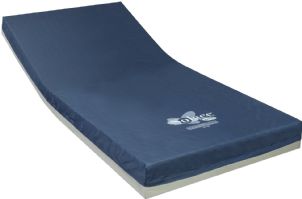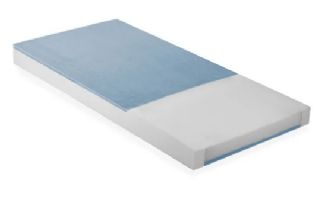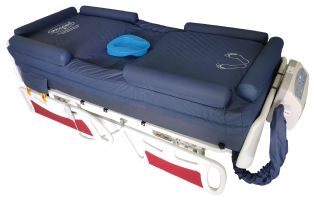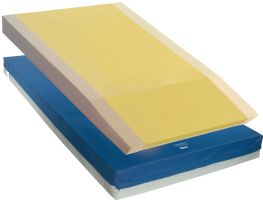 Written by Megan Smith, PT
Written by Megan Smith, PT
Pressure relief mattresses are essential in redistributing pressure and protecting vulnerable areas. Bedridden people spend long hours in bed or have difficulty changing positions are at risk for pressure sores. When choosing the right mattress, it's important to consider various features that fit your needs, because proper sleep is essential to healing and your overall well-being.
A pressure relief mattress is designed to protect against pressure ulcers, also known as bedsores. It provides support for the head and body, and it redistributes a person’s weight, which reduces the amount of pressure applied to any single area of the body.
Relieving and redistributing pressure reduces friction and shearing, which are key factors in the development of bedsores. Since constant pressure can cause skin injuries, pressure relief mattresses are particularly beneficial for individuals who spend extended time in bed, cannot reposition themselves independently, or have already developed pressure ulcers.
For patients who are completely immobile and unable to reposition themselves, a high-tech, adjustable mattress that offers periodic repositioning is essential for preventing pressure ulcers. These mattresses automatically inflate and deflate at set intervals, ensuring continuous pressure redistribution without requiring any movement from the patient.
Powered pressure relief mattresses, often referred to as “hi-tech” mattresses, offer the highest level of pressure redistribution, with the ability to adjust for the patient's comfort and treatment needs. However, they require proximity to an electrical outlet and backup battery power to function during a power outage. The built-in motors, pumps, or compressors can be noisy.
On the other hand, non-powered mattresses, or “low-tech” mattresses, are quieter, as they don't have any mechanical components, but they provide a more passive form of therapy. While they help distribute weight evenly, they do not reposition the patient, requiring manual repositioning every two hours.
Changing a patient's position in bed every 2 hours helps keep blood flowing, promoting skin health and warding off bedsores. If a patient can change positions independently or with minor assistance from a caregiver, the risk of pressure ulcers is lower and a low-tech pressure relief mattress is appropriate. If more help is needed for repositioning or the patient is too heavy for the caregiver to complete a bed turn, an automatic hi-tech pressure-relieving mattress can take that burden off the caregiver.
For patients at low risk of developing pressure ulcers or those with early-stage or superficial skin breakdown, reactive therapeutic mattresses that distribute weight across a large contact area can help prevent bedsores from forming or worsening. However, for patients at higher risk or those with more advanced wounds, high-tech adjustable mattresses that actively vary pressure and mechanically redistribute weight are a better choice to promote healing and prevent further complications.
Pressure relief mattresses are for people who spend a lot of time in bed. Constant contact with skin can create a moist environment that acts as a breeding ground for microbes. Keeping the mattress clean is necessary to create a healthy environment for the patient, so a mattress that is easy to clean is a necessity.
Mobility is often affected by age and medical conditions. A younger, healthier patient who spends significant time in bed but can still change positions independently is not at high risk for pressure ulcers and may not need a powered pressure relief mattress. However, for patients whose age or health conditions limit their ability to reposition themselves, an adjustable-powered mattress is essential for providing the necessary repositioning to prevent pressure ulcers.
Since a bedsore can develop when blood supply to the skin is cut off for more than two to three hours, anyone who spends the majority of the day in bed, especially if that person isn’t very mobile, is at risk for developing a pressure ulcer. The more time someone spends immobilized in bed, the more risk there is that skin issues will develop.
Pressure relief mattresses are generally designed to fit standard or bariatric home hospital beds or clinical setting hospital beds. They are not generally sized for standard home beds.
There are a couple of considerations when deciding on a mattress cover. It should be:
It should also add to the patient’s comfort, and not detract from it. It should make the bed surface more comfortable and not trap heat.
Since most mattress overlays measure only three inches thick, they will not prevent a patient from bottoming out, with the body’s pressure points resting on the surface underneath. And with overlays usually constructed of non-breathable vinyl, it can lead to overheating, sweating, and excess moisture on the skin, which creates an opportunity for skin breakdown. For comfort and microclimate management, a mattress rather than an overlay is usually preferable.
Although not the best choice for deep pressure wounds, memory foam is comfortable, breathable, hypoallergenic, and reduces pressure points to reduce the risk of developing bedsores.
When extended time in bed puts you at risk for developing pressure sores due to the inability to naturally and independently change positions frequently enough.
Anyone at risk of developing pressure ulcers or who seeks joint and structural pain relief from pressure point stress while in bed.
Pressure redistribution is static and therefore will have a constant pressure measurement. Pressure relief surfaces will have a changing measurement of the amount of pressure on an area of the body.
Yes, alternating pressure mattresses can help prevent pressure ulcers, with several chambers that are automatically filled with different amounts of air. If pressure ulcers haven’t developed, and a patient is not at high risk of pressure wounds, the weight redistribution of a low-tech static mattress can be enough to keep them from developing.
A ROHO mattress is an air mattress that conforms and adapts to the patient’s body shape, mimicking the pressure redistribution properties of water. This reduces friction and shear, which are the primary factors in the development of pressure ulcers.
Excessive pressure on areas like the hips and shoulders can disrupt spinal alignment and support, leading to pain. Pressure relief mattresses that evenly distribute body weight can alleviate this discomfort by reducing the strain on pressure points.
Pressure-relieving mattresses either distribute weight over a larger contact area in reactive therapy or mechanically distribute a patient’s weight over a large contact area in active therapy, varying the pressure beneath the patient to reduce the intensity and duration of pressure. Air, foam, and gel are low-tech mattresses, which do not provide adjustable pressure. Pressure-adjustable hi-tech mattresses can be inflated or deflated to adjust the pressure. These options all work in different ways and meet specific patient needs. Below, we give you the details of each type of mattress.
 | Allay GelFlex Foam Pressure Redistribution Mattress View Product |
Gel mattresses are non-powered and conform to the user’s body, providing the sensation of sinking deeply into a mattress. Gel mattresses also retain less body heat, which creates a cooler sleeping surface than other materials. On their own, gel mattresses have a more responsive feel and users generally report a comfortable sleep experience. They are best for patients who are at lower levels of risk for developing pressure ulcers, or those who have only superficial bedsores. Typically, gel mattresses are not 100% gel; they are made of gel and another material.
 | Solace Prevention Therapeutic Foam Mattress by Invacare View Product |
Foam mattresses are low-tech static mattresses that can be cross-cut, which allows the cells of the mattress to shift along with the patient’s body, offering partial immersion and envelopment. This decreases the chances of the outer layer of skin tearing when the patient moves. This mattress type provides reactive therapy, applying constant lower pressure to skin and tissues until the patient is repositioned. Foam mattresses are best for patients who have a low level of risk of developing a pressure sore, or who have only superficial pressure ulcers.
 | Pressure Reducing Mattress Series 6500 Dynamic Elite by Drive Medical View Product |
Hybrid mattresses are made with foam and air and can be powered or non-powered. Non-powered hybrid models provide reactive therapy similar to what is provided by a foam mattress. Powered hybrid pressure-relieving mattresses deliver some active therapy, although they don’t offer the same level of pressure relief as alternating pressure air mattresses. Design options for a hybrid pressure relieving mattress include the foam being encased within the separate air cells or the foam in a later above the air cells. A hybrid mattress is suitable for patients who are at a high risk of developing pressure sores, or those with existing bedsores.
.jpg&newwidth=365&maxheight=200) | Safety Mattress with Raised Edges | 500 lbs. Capacity | Pressure Redistribution View Product |
Sometimes referred to as LAL mattresses, this kind of powered mattress is designed for patients who are already suffering from skin breakdown. It helps heal pressure sores that have already developed. This style delivers active therapy and has a pump or compressor running at all times to push air through tiny laser-drilled holes in the top of the mattress, helping to keep the patient cool and comfortable.
 | Meridian Satinair - Alternating Pressure Mattress System View Product |
Alternating pressure mattresses are powered mattresses with air bladders. A bladder slowly deflates and inflates, followed by an adjacent bladder deflating and re-inflating. that alternately slowly inflate and deflate. They run in cycles, usually taking about 10 minutes to go through all the bladders from one end of the bed to the other. This active therapy mattress is most effective for preventing skin breakdown.
 | Comfort Zone Bariatric Alternating Pressure Mattress with Low Air Loss LAL View Product |
Powered low air loss with alternating pressure mattresses prevent and treat skin pressure injuries through two therapy modes. One is alternating the deflation of every third cell during the programmable cycle time. The other therapy is static low air loss, which keeps skin dry and cool by managing the bed’s microclimate and moisture.
Best: Comfort Zone Bariatric Alternating Pressure Mattress with Low Air Loss LAL
_(1).jpg&newwidth=365&maxheight=200) | United Pressure Relief Hospital Bed Mattress View Product |
Pressure sores are areas of damaged skin caused by staying in one position for too long. They commonly form in bony areas like ankles, back, elbows, heels, and hips. Prevention consists of keeping skin clean and dry, changing positions to relieve pressure, and using products that specifically relieve pressure, like pressure-relieving mattresses. Advanced sores can be slow to heal, so prevention is key. If bedsores do develop, relieving the pressure on the affected area helps create an optimal healing environment.
 | Low Air Loss Mattress with 3 Layers, Bed Pan Access, and Inflatable Guardrail | OB-3682 UltraAir View Product |
Bedridden patients who are unable to change positions, or who are unconscious or otherwise unable to sense pain are at risk of pressure sores. These sores can cause serious and maybe even life-threatening infections. Pressure relief mattresses change the areas that are under constant pressure from being immobile or bedridden.
 | Drive Medical Gravity 9 Premium Long Term Care Pressure Redistribution Mattress View Product |
Since the heel is a common place for a pressure ulcer to develop, pressure relief mattresses with a heel slope lower the heel slightly, allowing the mattress to fill in the space behind the Achilles tendon. This distributes the pressure over the surface of the entire lower leg, reducing the contact to the heel.
 | Proex Pressure Relief Visco Elastic Memory Foam Mattress w/ Hospital Grade Cover View Product |
There are some pressure relief mattresses that come in twin, full or queen sizes, but this is a very small category. Most fit twin-size hospital beds designed to accommodate one person. Bariatric versions are available to serve patients who can’t fit comfortably or turn independently in a standard sized hospital bed.
 | Skil-Care Bariatric Mattress View Product |
Bariatric patients might have trouble repositioning themselves in bed, either because the bed is not sized appropriately or they are not physically mobile enough to do so. A hi-tech electric pressure relief mattress that automatically repositions a patient takes the physical strain of changing positions of the patient and caregiver.
Pressure relief mattresses are essential in managing pressure ulcers, providing support for the head and body to alleviate stress on pressure points and enhance patient comfort. While they significantly aid in preventing and healing bedsores, they do not replace the need for regular repositioning and vigilance.
These mattresses are a valuable tool in a comprehensive approach to pressure ulcer management. For more information on topics vetted by healthcare professionals, visit us at Caregiver University!

Megan has been a part of Rehabmart since its inception nearly 20 years ago. For the past several years she has been enjoying her role as HR Director while maintaining her Physical Therapy license. When she isn't working on her next in-service or working to find a new team member, she enjoys her five children, helping those who have PT type ailments, baking, practicing yoga, and working out.